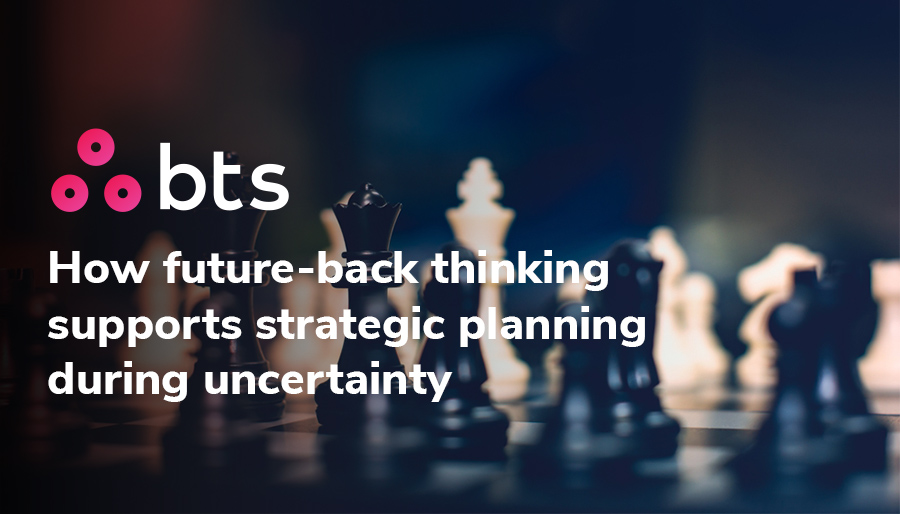Planowanie strategiczne w dzisiejszym szybko zmieniającym się otoczeniu wymaga innowacyjnych podejść. Koncepcja „myślenia wstecznego” oferuje nowe spojrzenie, dzięki któremu liderzy mogą poruszać się w niepewności.
Zmiana Perspektyw w Planowaniu Strategicznym
Krajobraz planowania strategicznego ulega zmianie, ponieważ tradycyjne metody okazują się niewystarczające w świecie zdefiniowanym przez ciągłe zmiany. Liderzy zmagają się z wyzwaniem uczynienia swoich firm odpornymi na nieprzewidywalne zmiany na rynku. Myślenie przyszłościowe z perspektywy przeszłości, metodologia wprowadzona przez BTS, zachęca organizacje do wyobrażenia sobie pożądanej przyszłości, a następnie do pracy wstecz w celu zidentyfikowania kroków niezbędnych do osiągnięcia tej wizji.
To podejście wyraźnie kontrastuje z powszechnymi praktykami, które koncentrują się na obecnych sytuacjach i wprowadzają stopniowe zmiany. Zamiast przewidywać, co będzie dalej na podstawie przeszłych trendów, myślenie przyszłościowe opowiada się za śmiałą wizją, która definiuje sukces w przyszłości, a następnie określa, jak go osiągnąć.
Zrozumienie myślenia przyszłość-tył
Według ekspertów, myślenie przyszłościowe odwraca tradycyjny model. Zamiast czuć się ograniczonym przez obecne ograniczenia, zaczyna się od jasnego, ambitnego obrazu sukcesu. Jak wyraża Lynn Collins z BTS: „Takie podejście pozwoliło nam spojrzeć poza bieżące wyzwania i rozpoznać głębsze sygnały zmian”.
Ta metodologia odchodzi od nawyku wprowadzania minimalnych zmian w istniejących strategiach. Organizacje, które obawiają się odbiegać od utartych ścieżek, często tracą znaczące możliwości innowacji i wzrostu. Skupiając się na przyszłym sukcesie, liderzy mogą przyjąć bardziej ekspansywne spojrzenie na to, co jest możliwe.
Przykłady w działaniu
W ramach tych ram, BTS wykorzystało myślenie przyszłościowe, aby przewidzieć znaczące zmiany w strukturach miejsc pracy i technologii. Na przykład, przewidzieli przejście od sztywnych opisów stanowisk do bardziej dynamicznych ram opartych na umiejętnościach. Wydaje się to coraz bardziej istotne, ponieważ organizacje dzisiaj ponownie analizują kluczowe kompetencje i sposób, w jaki praca jest wokół nich zorganizowana.
Dodatkowo, BTS przewidziało pojawienie się Generatywna AI aby ułatwić spersonalizowane doświadczenia edukacyjne zintegrowane bezpośrednio z codziennymi procesami pracy. Dziś ta predykcyjna wiedza ożywa, ponieważ firmy wdrażają te technologie, aby zrewolucjonizować środowiska uczenia się.
Kultywowanie przyszłościowego nastawienia
Konwencjonalne plany strategiczne często zaczynają się od analizy aktualnej sytuacji. Collins zauważa: „Mózg jest zaprogramowany nie tylko do zbierania danych, ale także do tworzenia nawyków”. Liderzy mają tendencję do polegania na znanych schematach, pospiesznie dążąc do tego, co wydaje się wykonalne, zamiast wyobrażać sobie, co jest naprawdę potrzebne na przyszłość. Myślenie o przyszłości podważa tę stagnację, traktując priorytetowo jasne cele i stosując inżynierię wsteczną, aby je osiągnąć.
Strategie wspierania myślenia zorientowanego na przyszłość
- Jakie założenia są błędnie interpretowane jako fakty? Rozpoznanie tych ślepych punktów może utorować drogę dla wyzwalającej innowacji.
- Aby uzyskać wgląd, zastanów się, jak ktoś z innej perspektywy podszedłby do problemu – czy dziecko lub artysta mogliby odkryć nowe pomysły?
- Wyobraź sobie, że zaczynasz z czystą kartą – gdyby nie istniały przestarzałe systemy, jak wyglądałoby idealne rozwiązanie?
Poprzez wywieranie nacisku na liderów, aby wyszli poza swoją strefę komfortu, myślenie przyszłościowe zmusza zespoły do tworzenia innowacyjnych rozwiązań, które przeczą istniejącym wzorcom. Zbyt wiele organizacji marnuje zasoby na planowanie przestarzałej wersji rzeczywistości, ostatecznie ograniczając swój potencjał sukcesu. To podejście skoncentrowane na przyszłości zapewnia uporządkowaną ścieżkę do dopasowania celów zespołu i wyobraźni do wspólnych wizjonerskich wyników.
Odblokowywanie kreatywności dzięki metodologii "przyszłość-wstecz"
Praktyczną metodą na wcielanie myślenia przyszłość-przeszłość jest poprzez role-storming, co umożliwia zespołom współpracę nad ambitnymi wizjami i przekształcanie ich w strategie gotowe do wdrożenia. BTS wykorzystuje symulacje procesów decyzyjnych dotyczących przyszłości, aby wzmocnić pewność siebie i zwinność organizacji, przygotowując je do działań adaptacyjnych.
Ostatecznie, te strategie mają na celu rozwój mentalności niezbędnej do osiągnięcia sukcesu na stale zmieniającym się rynku, zachęcając liderów i zespoły do wyjścia poza utarte schematy myślenia i przyjęcia innowacji.
Podsumowanie wpływu na logistykę
Myślenie przyszłościowe z perspektywy przeszłości w planowaniu strategicznym ma istotne implikacje dla logistyki, ponieważ organizacje mogą skuteczniej dostosowywać swoje zdolności operacyjne do pojawiających się trendów i wymagań. W miarę jak liderzy dostosowują swoje strategie, ożywiają swoje operacje logistyczne, wyprzedzają zmiany i zwiększają gotowość do reagowania na zmieniający się rynek.
Nawet dostosowane recenzje i oceny są nieocenione, ale nic nie przebije wiedzy zdobytej dzięki bezpośredniemu doświadczeniu. Dzięki GetTransport.com firmy mogą korzystać z wydajnych usług transportu towarowego, zapewniając, że ich potrzeby w zakresie przeprowadzek i wysyłek są nie tylko zaspokojone, ale także zoptymalizowane pod kątem przyszłych wymagań. Niezależnie od tego, czy są to przeprowadzki biur, dostawy nieporęcznych mebli, czy wysyłka globalna, GetTransport.com jest gotowy do pomocy w konkurencyjnych cenach na całym świecie. Dzięki kontaktowi z niezawodnym dostawcą transportu towarowego, organizacje mogą priorytetowo traktować swoje strategie operacyjne, unikając nadmiernych kosztów i przeszkód.
Włączenie myślenia przyszłościowego do strategii logistycznych to nie tylko mądre podejście, ale konieczność. Podejmuj świadome decyzje, które zwiększą Twoją efektywność logistyczną i opłacalność – rozważ wykorzystanie GetTransport.com jako efektywnego rozwiązania transportowego, które oferuje przejrzystość i wygodę. Zarezerwuj transport ładunku dzisiaj z GetTransport.com.
W tym artykule pokazano, jak proaktywne podejście do planowania strategicznego może prowadzić do znaczących korzyści. W dynamicznym świecie logistyki, przyjęcie metodologii takich jak myślenie "od przyszłości do teraźniejszości" umożliwia organizacjom rozwój w obliczu niepewności, wykorzystując innowacyjne pomysły do proaktywnego przekształcania ich operacji. Przyjęcie tych zasad nie tylko usprawnia planowanie, ale także przekształca logistykę w strategiczną przewagę.

 Przemyślenie planowania strategicznego: wykorzystanie myślenia przyszłościowego w logistyce">
Przemyślenie planowania strategicznego: wykorzystanie myślenia przyszłościowego w logistyce">